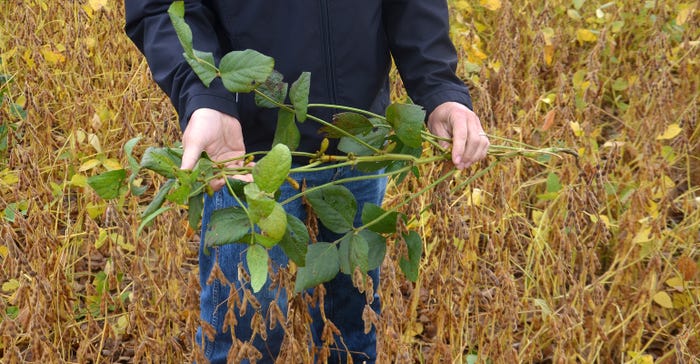
Editor’s note: A version of this story originally appeared on Oct. 21 on the Indiana Prairie Farmer website. Sources were unaware at the time that some plant specimens similar to those shown with the story were sent to the Purdue University Plant and Pest Diagnostic Laboratory and tested negative for the tobacco ringspot virus of soybean. Sources stand by the story. However, it’s important to note that tobacco ringspot virus has yet to be confirmed in Indiana by a plant diagnostic lab, as of this writing. Purdue Extension disease specialist Darcy Telenko says it is possible similar symptoms could be caused by environmental conditions. It’s also possible that the plants referred to here were infected by tobacco ringspot virus, but that was not confirmed by testing.
If you see plants that could be infected with tobacco ringspot virus of soybean, or that have similar symptoms, you won’t miss them. The telltale symptom is often a tiny bunch of very short pods trying to develop in a clump on an upper node. If the rest of the field is nearly mature, afflicted plants remain as green as grass.
“I had never seen these symptoms until this season,” says Steve Gauck, a veteran sales agronomist with Beck’s, Greensburg, Ind. “I got a couple reports from customers in Johnson County and also from someone in northern Indiana.
“Then I found it on Oct. 7 in the Soybean Watch ’19 field in Johnson County.” Beck’s sponsors Soybean Watch ’19. “That same day, I found it in Jackson County,” he adds. Later, Gauck found plants with the same symptoms in Decatur County.
While affected plants are far too scattered to impact yield, it’s hard to miss them, Gauck says. Affected plants have few pods. A few pods may have one or more beans in them. They seldom mature, however.
In the Soybean Watch ’19 field, Gauck found symptoms in all three varieties in the field, so it’s obviously not variety-specific. Seed in the field came from two different companies.
More details
After she was forwarded a picture of a plant from the Soybean Watch ’19 field, Darcy Telenko, Purdue University Extension disease specialist, indicated it could be tobacco ringspot virus of soybean. She notes that she hasn’t personally seen it very often. Plants shown here weren’t sent for confirmation.
A few plants sent by others tested negative for the disease. It is possible environmental conditions could cause similar symptoms, Telenko says.

GREEN PLANTS, FEW PODS: You won’t fill the combine hopper from this plant. It could be infected with tobacco ringspot virus of soybean. There are few pods on the plant, and the beans usually don’t mature.

If you want to learn more about tobacco ringspot virus, Telenko suggests visiting this Crop Protection Network web page. The website is developed and sponsored by an organization of land-grant universities.
Known as TRSV, the disease can be transmitted from plant to plant by sap, mechanically and by infected seed. It tends to be favored by hot, dry weather. Those conditions dominated the latter part of the season in much of Indiana.
If TRSV is present, rotation to corn can help control it, Telenko says. You also want to make sure you’re buying clean seed. Send suspected TRSV samples to a diagnostic lab for testing. Find contact information for labs online.
About the Author(s)
You May Also Like




